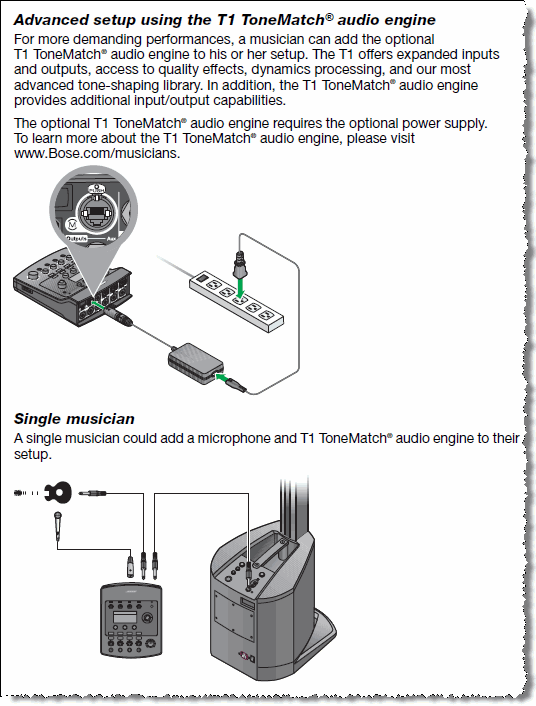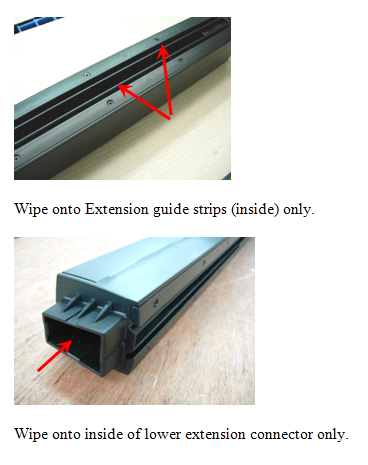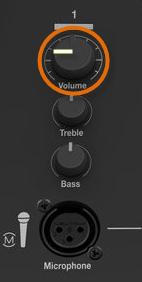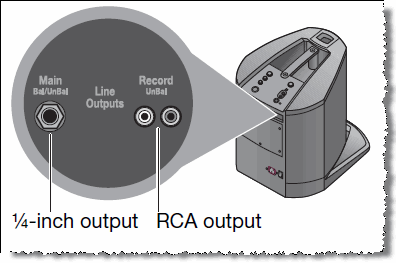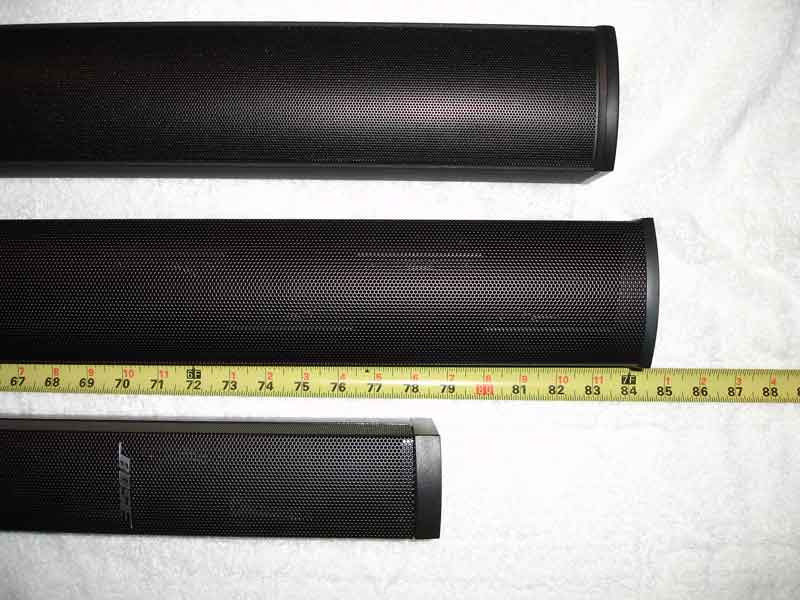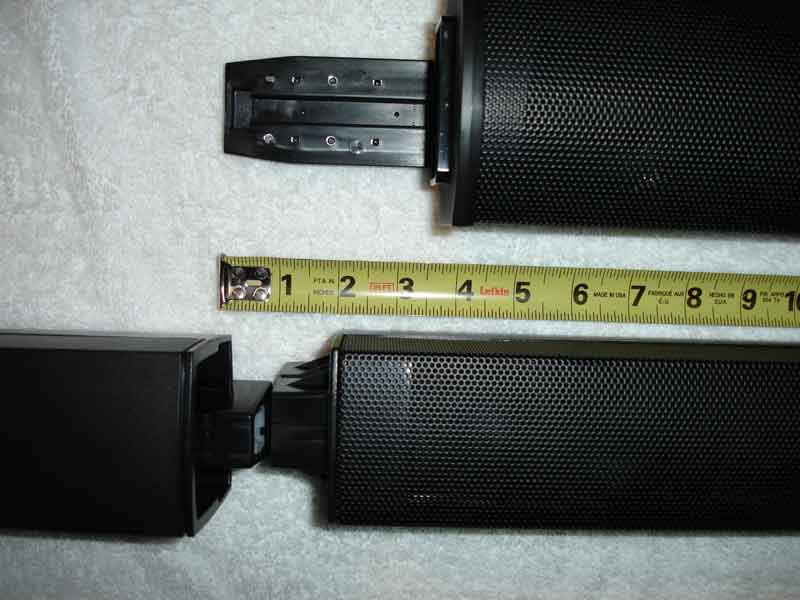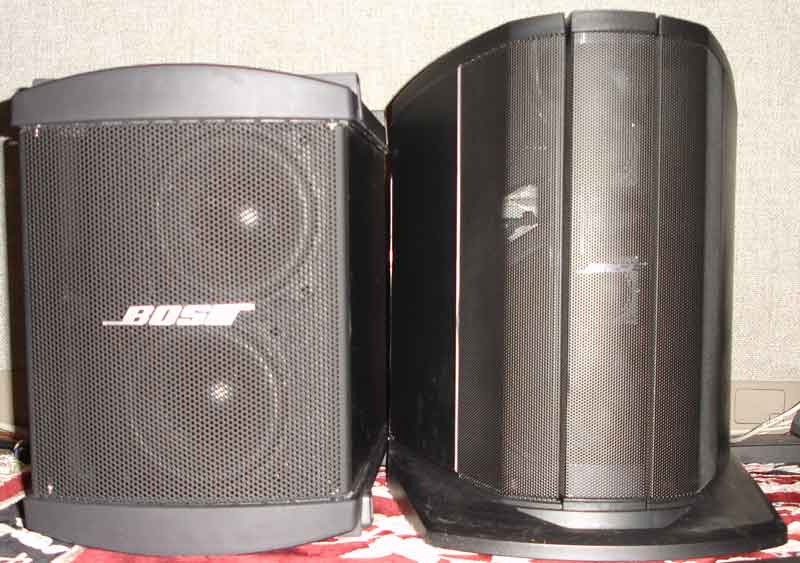L1® Compact
Interactive Tools
Videos
Documents and Resources
- L1® Compact FAQ (pdf format)
- L1® Compact Technical Data
- L1® Compact Features Functions and Benefits (pdf format)
- L1® Compact Interactive Tour
L1® Products Comparison
FAQs from the Bose® Pro Portable PA Community
Presets
Channel 1:
- T1 ToneMatch® Audio Engine equivalent: Handheld Mics
- L1® Model I equivalent: 01 Handheld Microphones
Channel 2:
- T1 ToneMatch® Audio Engine equivalent: Acoustic Guitar w/piezo
- L1® Model I equivalent: 40 Acoustic Guitar w/piezo
L1® Compact Microphone Accessory Pack
Contents:
- Audix OM3 microphone
- Audix CBL-20 20' XLR cable
- Stereo RCA cable
- 3.5mm Stereo mini cable
The Hand held Mic or Audix OM3 preset both work great.
To obtain pricing and availability please contact 800-444-2673.
Universal Power Supply
The L1 Compact system features a switching power supply that allows it to operate in regions ranging from 100V – 240V. The proper power cord for the specific region in which the system was purchased is included in the product carton.
Available in Bose Retail Stores
The L1 Compact will be offered in all Bose retail stores, the L1 model I and model II will remain in select stores only.
Extensions
The extensions are interchangeable. They contain no speakers.
You can use either or both extensions but we didn't see applications where there are advantages to using one so we don't promote it that way.
- Extended Position
Recommended for larger audiences, the extended position allows users to elevate the L1 Compact loudspeaker array, enabling it to project sound clearly and evenly throughout larger venues. Included with the L1 Compact system are two interlocking L1 Compact extensions used to elevate the array.
- Collapsed Position
Recommended for smaller audiences, the collapsed position allows the L1 Compact loudspeaker array to be inserted in the front of the power stand, creating a very small profile. When used in this position, the system should be placed on top of a table or elevated stage. This will allow sound to project clearly and evenly throughout the room.
For optimal performance we recommend using both extensions when the system is set up in its Extended position.
Drivers
Array Section
There are six high power drivers in the array section.
Vertical Dispersion
- With the Models I and II, I have had to tilt them forward on occasion (no more than an inch on the PS cabinet or back legs) because the output pattern is so horizontal. This made a very audible improvement for the back seats.
I expect, with the Compact, this will no longer be necessary due to the new array configuration. Any idea what the vertical dispersion angle is on the high end? Bose Guy in Calgary
Plus or minus 20 degrees. No tilting needed.
The vertical dispersion is only +-20 degrees which is pretty confined compared to most stand mounted speakers.
The curvature in the array is to achieve the +-20 degree vertical pattern. We designed for that pattern so the speaker would work in a typical raked seating area -- something we thought the L1 Compact system would be used for a lot, and we wanted to make sure that those seated in the front row of a cramped venue with the product in it's extended position would still get sound.
Convex arrangement of 6 speaker array
- I'm curious about the slight 'convex' arrangement of the 6-speaker array. Why that rather than a straight or even a slightly 'concave' arrangement? Source: Dan Cornett
The vertical convexity of the HF array will actually produce a very useful vertical dispersion at HF. The unit needs this. IF it were a straight array, you'd be shooting over the heads of, say, people seated in front of a bandstand looking up. That geometry coupled with the driver articulation (like the L1/II) makes for a spectacular distribution of sound, especially in the HF. It's amazing when you hear it.
Power Stand
The L1 Compact systems power stand has integrated bass with an 8" woofer and will play down to 65hz. The drivers in the loudspeaker array are indeed smaller than those used in the L1 model I and model II systems.
Crossover
We moved the crossover up to 400-ish.
Voicing / T1 ToneMatch® Audio Engine
We voiced all the L1 systems the same, so that tone would be the same on each.
Also, that makes it possible for the T1 audio engine to travel from say a Model II to an L1 Compact system with no additional change of settings on the T1.
Comparisons to Other Members of the L1® Family
These are anecdotes from people-at-Bose.
Ken-at-Bose
What I would say is that the L1 Compact system does not play as loud, nor as deep in bass, nor does it project as far into a room as either the L1 Model I or Model II.
It doesn't really offer expandable bass.
We think its performance and price are very appealing to a large number of people for whom the performance and price of the Model I or Model II are unnecessarily high.
If I played in bigger, noisier rooms, used bass and drums, or played hard driving rock/blues/metal, or had an instrument that really shined because of deep bass etc. I should be steered to the Model I or Model II.
For a quiet, attentive audience I would think that a singer songwriter could comfortably entertain 150 people, give or take, with an L1 Compact system
If the room or people are noisy, take that down to 50.
Cliff-at-Bose
First of all, the L1® Compact is very different in basic nature from the two original ones. It has a head-high vertically-divergent array that is ultra-wide horizontally. the vertical angle is narrow enough so its sound pressure fall-off with distance is not as severe as, say, a guitar amp, but it's somewhat greater than an L1 I or II. We have data galore taken on the L1C array, but to a musician, its not only useless, it's confusing. Thinking about this stuff intellectually leads nowhere.
So, forgetting all this, The L1® Compact sounds the same and, from personal experience playing and singing solo, it feels the same. When I played (this seems to be a typical configuration), the system was off to the side 5' and back of me 4'. It is louder when you get on top of it (unlike the L1) so you need to get a little further from it. But not much.
It's very well behaved and it's easy to arrive at an organically-correct distance from it. But; bottom line; it really behaves like the other L1's. I know it has less overall output than the big ones, but I never felt that limit playing demos for a variety of audiences prior to yesterday's launch. I know the system will allow me to entertain at a level I'm happy with in our live music theater. I really don't want more level from it. Our theater holds over 100 and is acoustically treated to be pretty dry. Charlie Farrin did the same on a number of occasions. He's an experienced pro, playing guitar and singing to demonstrate for other audiences. As an audience member listening to Charlie, I was delighted with the sound quality and level. It was exceptionally articulate musically and I understood all his words, on songs I wasn't familiar with.
I'm guessing if you're playing guitar or keys and singing (a solo gig), you can play for 100 with great quality. I never thought once about the capacity of the LF. My keys are never exaggerated on the low end and I want them to sound like, for instance, a real piano or a Rhodes Suitcase. I'm guessing an organ player playing a heavy bass line and singing, like a solo gig, might put the thing to the test. I haven't experienced this and don't do it myself.
Connections from a T1®
This refers to the connection from a T1 ToneMatch Audio Engine Master or Aux Output using ¼ inch jack connections.
¼ Inch Tip-Ring-Sleeve (balanced) to ¼ Inch Tip-Ring-Sleeve (balanced)
A balanced connection is preferred and will provide better noise rejection over greater distances than the unbalanced connection.
¼ Inch Tip-Ring-Sleeve (unbalanced) to ¼ Inch Tip-Sleeve (unbalanced)
This should work fine but a balanced connection (immediately above) is preferred especially if you will have cable runs in excess of 20 feet (6 meters) or if you hear line noise, hum or hiss.
This is page 12 of the L1® Compact Owner's Guide (pdf format)
AC Power
This is especially for those who want to run the L1 Compact with an inverter connected to a car battery or from a Power Pack.
Note: The L1 Compact accepts all AC Power In voltages from 100V to 240V, the different part numbers change the power cord in the box.
Here is the AC Power in levels we have measured on the L1 Compact, please realize that these are approximate and vary greatly with audio content.
Power 230V 120V 100V
Idle: 12W 0.06A 0.1A 0.12A
(no audio)
Filling a room: 30W 0.14A 0.25A 0.3A
Full Out: 60W 0.3A 0.5A 0.6A
(Red LED blinking)
Note: The AC line power in can peak around 100W during a loud burst.
We have also tested the L1 Compact with several DC to AC Inverters, mostly the low cost "Modified Sine Wave" (actually three level square wave) ones and all have worked very well, there is no buzz problem from the ones we tried. I recommend that an inverter of at least 300W be used ($30 to $35 US), less then that has not been tested.
Here are measurements we took, realize this also includes the inverter efficiency:
Current from 12V Battery to Inverter
Idle: 12W 1.5 Amps from battery
Filling a room: 30W 3 Amps from battery
Full Out: 60W 6 Amps from battery
There are also "Power Packs" available which have the battery built in with the inverter. To find out how long one of the "Portable Power Packs" will run divide the amp hour rating of the battery by the amps from the list above (usually divide by 3), this is assuming it uses a 12V battery.
Compact Extensions Sticking
All,
For those folks that are experiencing this issue we can confirm that using a “dry lubricant with Teflon” would be an acceptable solution. This can be sprayed onto a cloth and wiped onto the inside of the extension & array tracks and the inside of the lower extension electrical housing.
Note: Please do not spray directly near the electrical connections:
There are many manufactures that offer similar products, one in particular that we have used in the past with success is the TRI−FLOW* Superior Dry Lubricant with Teflon* produced by Sherwin-Williams, please note that we do not endorse any one product in particular – we are merely trying to provide you with a point of reference.
I hope this information is helpful.
Thank you, Neil
original discussion: Compact Extensions Getting Difficult to Insert
Channel 1
Question: Channel One on the L1 Compact seems noisy.
Response from Craig-at-Bose
First and most importantly, please make sure that you have a microphone connected when you turn up the Channel 1 Volume control. As other members of the community pointed out, when the Channel 1 Volume control is set to 12:00 o'clock the system is extremely loud. Below are some additional details as well as guidelines for adjusting your levels. Please read through my post and let me know if you have any further questions.
We’ve designed the L1 Compact with the goal of providing a simple user interface for both musicians and general purpose users. You will notice there is volume control for each Channel but no overall Master volume. This means that the power amp section is always at full gain. In this configuration the Channel and Channel 2 volume controls are effectively acting as trim controls. The benefit of a trim control is that you don’t need to significant gain in order to drive the L1 Compact to full output.
The L1 Compact microphone channel is designed to work with a wide range of hand held microphones from popular microphones like a Shure Beta 58A all the way to lower sensitivity microphones like the Sennheiser e8155. As you may know sensitivity can vary between microphones so we’ve elected to include a higher amount of gain on the microphone channel.
In order to maximize signal to noise (when using the L1 Compact Channel One microphone channel) we recommend that you determine the loudest level that is required for your room/application and follow the steps below.
- Plug in your microphone to Channel 1
- Turn the L1 Compact Channel 1 Volume / Trim to 9 o’clock
- Speak into the microphone at your loudest volume and softest volume
- Adjust the Channel 1 Volume / Trim control to a setting that will work for your loud and soft vocal passages.
- Remember since this is effectively a trim control (and the master is at full) you don’t need to build additional headroom into the system.
- Additional tip: In most cases, the Channel 1 Microphone Preamp has more gain than you will ever need, so if you don’t need the extra gain, don’t use it as it will only introduce noise.
Thanks, Craig
Line Out
From the Owners Guide
Rear panel outputs
¼-inch output – Mono analog output that accepts either ¼ inch TRS balanced or TS unbalanced cables. Can be used to link multiple L1® Compact systems together by connecting the ¼-inch output from one L1® Compact system to the ¼-inch input (Channel 2) on a second L1® Compact system. This will provide additional coverage in larger spaces. You can also use the ¼-inch output to connect to a house PA system and use the L1® Compact system as your personal monitor.
Note: Using a TS unbalanced cable will result in a drop in the audio level of -6dBu.
¼ inch jack output EQ
The Compact has a balanced line-out that is a mix of all the inputs, post level and EQ settings on the input panel. The signal at the line out will be full range down to 30 Hz. There is an exception. The Channel 2 input will be band-pass above 60 Hz (nothing below that) when the ToneMatch® switch is ON (up position). The other inputs are unaffected.
- If the Tonematch switch is engaged on Channel 2 then sources connected to the 1/4" input will not pass anything below 60Hz out of the line outputs.
- This does not apply to the 1/8" and RCA inputs which will pass information down to 30Hz through the line outputs regardless of where the ToneMatch switch is positioned.
- If the ToneMatch switch is set to line level sources connected to the 1/4" input will also pass information down to 30Hz through the line outputs.
Physical Comparison to other L1® Products
System Heights (fully assembled)
Fully assembled height
- Model I / Classic: 82.75
- Model II: 84 inches
- Compact: 78.5 inches
Assembly Clearance
You need 2 inches above the height of the Compact's fully extended height to assemble it.
- Compact = 78.5 + 2.0 = 80.5
That is compared to four inches clearance for the
- Model II = 84 + 4 = 88
- Model I = 82.75 + 4 = 86.75
- Classic = 82.75 + 6 = 88.75 (long bayonet setting)
B1 and Compact
Zusammenfassung in Deutsch
Hier eine kurze (allerdings unvollständige) Zusammenfassung in deutsch:
- Das Abstrahlverhalten i.d. Breite (horizontal) soll aber praktisch identisch mit der L1-Familie sein. Die vertikale Abstrahlung soll bei etwa +/-20° liegen, d.h. man muss die Säule nicht mehr kippen, z.B. um die Zuhörer direkt v.d. Bühne oder auf nach hinten ansteigenden Sitzreihen zu erreichen.
- Reichweite: Die L1® Compact trägt wegen der kürzeren Säule (mit 6 Hochleistungs-Treibern) nicht ganz so weit wie die "grosse" L1, d.h. die Lautstärke fällt mit zunehmender Entfernung etwas mehr ab.
- Leistung: Klar, daß die L1® Compact u.a. aufgrund des deutlich geringeren Gewichtes weniger Leistung als die anderen L1-Modelle hat. Dennoch reicht die Leistung aus, um 150 "ruhige" Zuhörer mit hervorragendem Sound zu versorgen, - bei lauterem Publikum reduziert sich diese Zahl allerdings auf etwa 50 Leute.
Aber natürlich gilt auch hier: Selber hören u. sehen ist besser als viel lesen.
Source: BlackForestMan Wolfgang
Expanded Text from the L1® Compact Page
L1® Compact system
- Bose® Spatial Dispersion™ loudspeaker technology delivers sound evenly across the stage and throughout the audience—even to the extreme sides
- Two ToneMatch® channels with fixed presets for a handheld microphone and an acoustic guitar
- Integrated bass speaker in power stand
- Two setup positions: collapsed for smaller spaces or extended for larger ones
- Ideal for musical performances, mobile DJs, classrooms, business presentations and other events
Introducing the L1 Compact portable line array system. Carry it in one trip. Set it up in one minute. Fill the room with Bose sound.
The new L1 Compact system combines conventional PA and monitors into one sleek unit. Positioned behind or to the side of a performer, DJ or presenter, it delivers wide, even sound coverage throughout the stage area and audience—even off to the extreme sides. It's our smallest, lightest, easiest-to-set-up L1 system, weighing just 29 pounds.
Big sound. Small package
Now you can have quality Bose sound for almost any gig, event or occasion. The L1 Compact system is small enough to fit in your trunk or back seat, and its innovative modular design makes setup easy and fast. You can arrange it in either a collapsed configuration for smaller spaces or a taller, extended configuration for larger ones. No extra gear to haul. No heavy speakers to hoist onto stands. No speaker cables.
A different loudspeaker
The L1 Compact system's slim loudspeaker distributes sound clearly and evenly throughout the room, thanks to Bose Spatial Dispersion technology. The speaker's unusual vertical shape makes it distinctly different from conventional PA speakers―and has a very positive effect on sound coverage. Even audience and band members off to the extreme sides hear the same clear, tonally balanced sound as those in front.
The L1 Compact loudspeaker array is smaller than those in L1 Model I and II systems, but it produces comparable horizontal sound coverage. L1 Model I and Model II loudspeakers project sound further with less dropoff of volume than the L1 Compact array.
Integrated system
With the L1 Compact system, you don't have to carry a separate amplifier, mixer or bass cabinet: They're already built in. The system's power stand includes an integrated bass speaker and amplifier, plus a built-in mixer providing a total of four inputs and two outputs.
Channel 1 is a microphone input with a customized ToneMatch preset for a handheld dynamic microphone. The preset automatically optimizes a handheld microphone's tone when used with the L1 Compact system. Channel 2 accepts up to three inputs at once, including a guitar, keyboard or other instrument, DJ mixer, MP3 player, laptop or projector. It features a customized ToneMatch preset to optimize the sound of an acoustic guitar.
The new L1 Compact system: audio performance, simplified setup and one-trip portability. Only from Bose.


